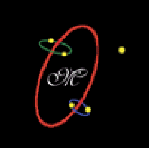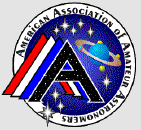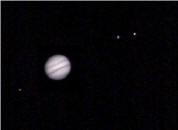XII. Conclusions
AAAA members participated in a regular early-morning observing program
named Project Jupiter in the Fall of 2002. During each session the
separation between planet Jupiter and several of its Moons was recorded.
The observational data obtained by Tim Tyler was entered into an EXCEL
spreadsheet, determining the best estimate of the orbital periods:
- 1.7706 days for Jupiterís moon Io,
- 3.5569 days for Jupiterís moon Europa,
- 7.1977 days for Jupiterís moon Ganymede and
- 16.6936 days for Jupiterís moon Callisto .
The observational data was also used to calculate the mass of Jupiter
as 1.8924E27 Kg, a value within 0.3% of available reference data, the
weight of objects on Jupiter, and the escape velocity on Jupiter. Similar
accuracies were obtained for each of the values.
Due to Timís high accuracy in determining the positions of the moons of
Jupiter, the mass of Jupiter was also obtained without a reliance on one
common assumption. When that assumption was removed, the mass of Jupiter
was determined to within 2.4%, a notable achievement!
Attachment C is a suggested press release highlighting Quad-A member
Tim Tylerís participation in Project Jupiter.



